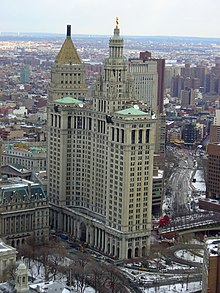Municipal Building (New York)
| Municipal Building | |
|---|---|

|
|
| Municipal Building | |
| Basic data | |
| Place: | New York City |
| Construction time : | 1907-1914 |
| Opening: | 1914 |
| Status : | Built |
| Architectural style : | Renaissance |
| Architect : | William M. Kendall |
| Use / legal | |
| Usage : | office |
| Technical specifications | |
| Height : | 180 m |
| Height to the top: | 180 m |
| Floors : | 40 |
| address | |
| Address: | 1 Center Street |
The Municipal Building is a municipal (municipal = municipal) administration building in the extreme south of the New York borough of Manhattan . It was built from 1907 to 1914. The architect was William M. Kendall.
When Greater New York was created in 1898 through the amalgamation of previously independent districts, a new administrative center was needed. The City Beautiful Initiative emerged from the Chicago World's Fair in 1893 , the aim of which was to give the new administrative buildings in the big cities an appropriate aesthetic. In this way, the building was supposed to take on an aesthetic role model in order to influence the developing architecture of the big city. There were similar tendencies in European Art Nouveau . This plays a role in structures that are close in time, such as the Equitable Building .
The Municipal Building does not form a block. The two outer sections are each offset by 45 degrees so that the outer part forms a right angle to the central wing.
The elaborate design of the tip had already established itself as a tradition in New York high-rise construction. A group of towers was placed over the middle of the building block, which clearly shows similarities to Gothic pinnacles, but works with classical forms. The area below is decorated with elements of the Renaissance .
This vacillation between neoclassicism and neo-Gothic is characteristic of the first generation of skyscrapers. At the beginning of the 20th century, these skyscrapers in Manhattan saw a similar dispute as one hundred years earlier in Europe. Decades later New York will no longer stick to traditional European art history, but here they still did. The fact that the New York skyscraper architecture actually partially refers to classical antiquity with its columnar scheme becomes clear in the Municipal Building above all in a strange construction, a colonnade arrangement on the ground level, which connects the two protruding outer components of the building and thus so creates something like a courtyard.
With a height of 177 m and 32 floors, it was the third tallest building in the world when it was completed.
The Municipal Building from 1907 to 1914 had a significant impact on the architecture of Moscow . It is said to have impressed Josef Stalin so much that he took it as a model for Moscow's Lomonosov University from 1947 to 1952. The architecture of the Stalin era in the Soviet Union took an example from a building of the class enemy .
The New York City Landmarks Preservation Commission designated the building a New York City Landmark in 1966 and it was listed on the National Register of Historic Places .
literature
- DuMont visual New York. 4th edition. DuMont, Cologne 1994, ISBN 3-7701-3247-5 , pp. 96, 182.
- Lester Brooks, Patricia Brooks, Susan Farewell: New York. RV-Verlag, Munich 1997, ISBN 3-89480-902-7 , p. 85.
- Paul Goldberger: Skyscraper. The skyscraper in the past and present. DVA, Stuttgart 1984, ISBN 3-421-02813-3 , p. 49.
Web links
Individual evidence
- ^ Edward Lucie-Smith, Sam Hunter, Adolf Max Vogt : Art of the Present 1940–1980. Propylaeen-Verlag, Frankfurt am Main / Berlin / Vienna 1985, ill.364a. (= Propylaea art history, vol. 13.)
- ^ Municipal Building ( English ) New York City Landmarks Preservation Commission . February 1, 1966. Retrieved July 3, 2020.
- ↑ Federal Register: 44 Fed. Reg. 7107 (Feb. 6, 1979) ( English ) Library of Congress . S. 7539. February 6, 1979. Archived from the original on December 30, 2018. Retrieved July 3, 2020.
Coordinates: 40 ° 42 ′ 46.7 ″ N , 74 ° 0 ′ 14 ″ W.
